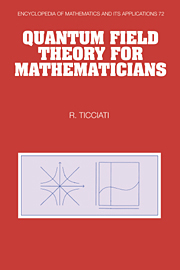Book contents
- Frontmatter
- Contents
- Preface
- Introduction
- 1 Relativistic Quantum Mechanics
- 2 Fock Space, the Scalar Field, and Canonical Quantization
- 3 Symmetries and Conservation Laws
- 4 From Dyson's Formula to Feynman Rules
- 5 Differential Transition Probabilities and Predictions
- 6 Representations of the Lorentz Group
- 7 Two-Component Spinor Fields
- 8 Four-Component Spinor Fields
- 9 Vector Fields and Gauge Invariance
- 10 Reformulating Scattering Theory
- 11 Functional Integral Quantization
- 12 Quantization of Gauge Theories
- 13 Anomalies and Vacua in Gauge Theories
- 14 SU(3) Representation Theory
- 15 The Structure of the Standard Model
- 16 Hadrons, Flavor Symmetry, and Nucleon-Pion Interactions
- 17 Tree-Level Applications of the Standard Model
- 18 Regularization and Renormalization
- 19 Renormalization of QED: Three Primitive Divergences
- 20 Renormalization and Preservation of Symmetries
- 21 The Renormalization Group Equations
- Appendix
- References
- Index
4 - From Dyson's Formula to Feynman Rules
Published online by Cambridge University Press: 31 October 2009
- Frontmatter
- Contents
- Preface
- Introduction
- 1 Relativistic Quantum Mechanics
- 2 Fock Space, the Scalar Field, and Canonical Quantization
- 3 Symmetries and Conservation Laws
- 4 From Dyson's Formula to Feynman Rules
- 5 Differential Transition Probabilities and Predictions
- 6 Representations of the Lorentz Group
- 7 Two-Component Spinor Fields
- 8 Four-Component Spinor Fields
- 9 Vector Fields and Gauge Invariance
- 10 Reformulating Scattering Theory
- 11 Functional Integral Quantization
- 12 Quantization of Gauge Theories
- 13 Anomalies and Vacua in Gauge Theories
- 14 SU(3) Representation Theory
- 15 The Structure of the Standard Model
- 16 Hadrons, Flavor Symmetry, and Nucleon-Pion Interactions
- 17 Tree-Level Applications of the Standard Model
- 18 Regularization and Renormalization
- 19 Renormalization of QED: Three Primitive Divergences
- 20 Renormalization and Preservation of Symmetries
- 21 The Renormalization Group Equations
- Appendix
- References
- Index
Summary
On the basis of canonical quantization of free fields, by means of the interaction picture which expresses the evolution of interacting fields in terms of the free field, the scattering matrix is first expressed in Dyson's formula as a perturbation series in a free-field Hamiltonian, then converted to Wick's operator expansion, and finally reduced to matrix elements and the Feynman perturbation series.
Introduction
Now that, through symmetries and conserved quantities, we have some constraints on the possibilities for the evolution of a state, it is time to develop the machinery for computing the structure of an evolving state. At the end of Chapter 2, we observed that canonical quantization of an interacting field theory could not be carried out on account of the normal-ordering problem. This chapter describes Dyson's technique for viewing an interacting field in terms of a free field, thereby quantizing an interacting theory on the basis of the canonical quantization of a free theory. This technique is intrinsically perturbative, being in effect equivalent to the asymptotic series defined by Feynman diagrams and rules, and could be called perturbative canonical quantization.
Section 4.1 presents the fundamental principle of perturbative canonical quantization, namely the interaction picture, in which the states evolve in a modified Schrödinger fashion, and the operators evolve like Heisenberg operators in a free-field theory.
- Type
- Chapter
- Information
- Quantum Field Theory for Mathematicians , pp. 79 - 120Publisher: Cambridge University PressPrint publication year: 1999



